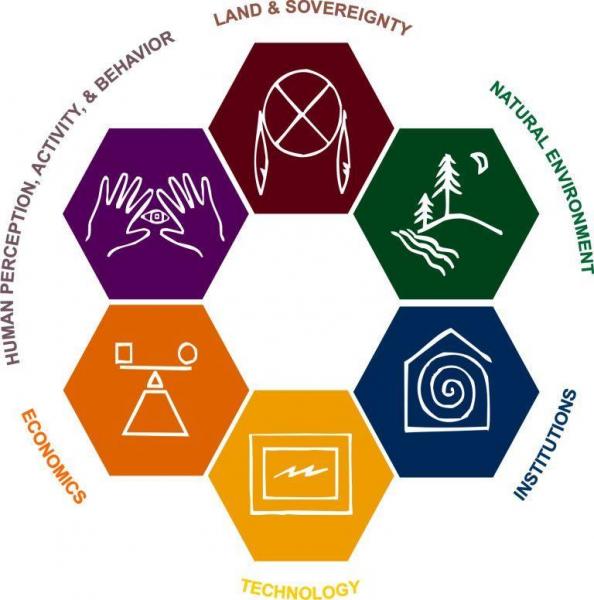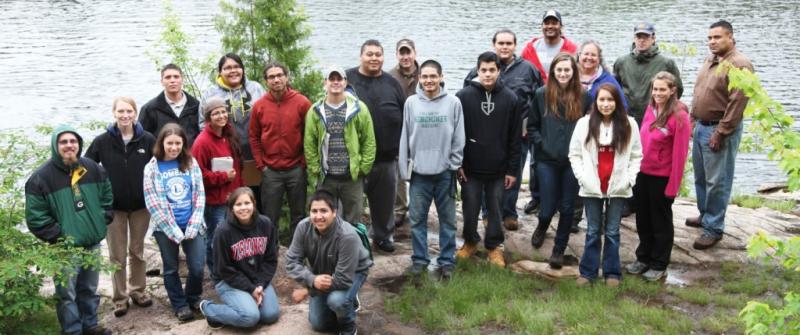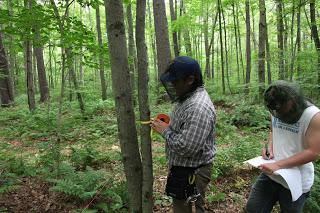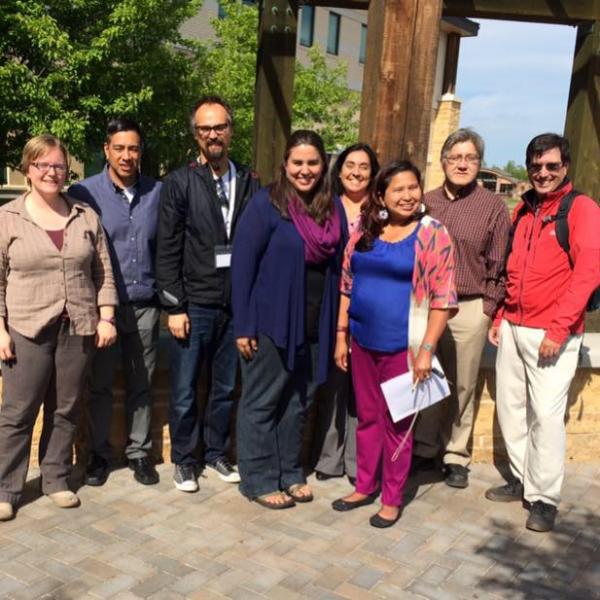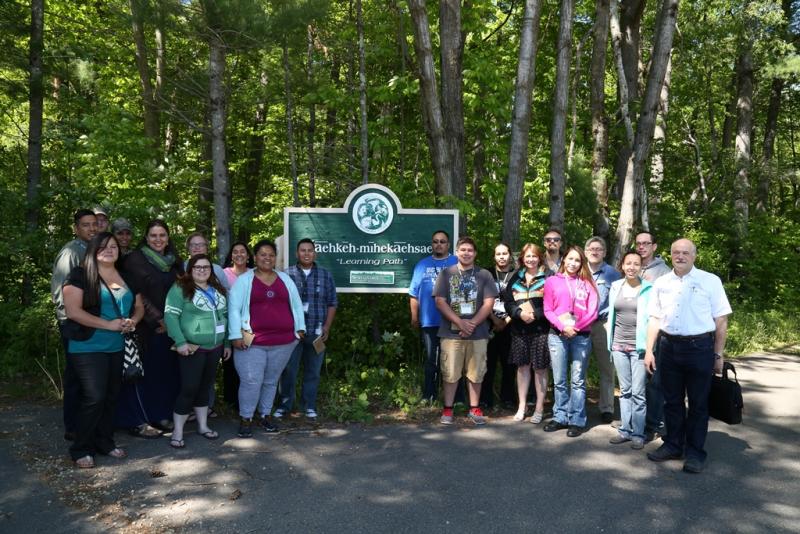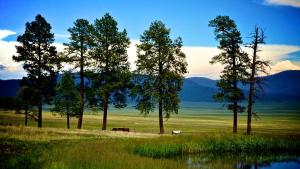Climate change—a threat and an opportunity
Climate change poses a threat to the traditional livelihoods and the sustainably managed forestlands of the Menominee Nation. However, climate change also presents an opportunity—a chance to apply indigenous knowledge to adapt and sustain native communities, and for the Menominee Nation to share its understandings with others seeking to address this global issue.
The Sustainable Development Institute (SDI) at the College of Menominee Nation works with both tribes and non-tribal communities on issues related to sustainability. The Institute combines Western-style research methods with indigenous knowledge to develop a variety of research projects and outreach initatives, with a focus on the inclusion and development of students—both from indigenous and other communities—to prepare the next generation of scientists and practitioners to become responsible community members.
An indigenous-based theoretical model of sustainability
An indigenous-based theoretical model of sustainability was developed through a collaborative approach by tribal leaders, who were interested in expanding on the Menominee's experience in sustainable forestry; through this effort, the Sustainable Development Institute was founded at the College of Menominee Nation to apply the model. The SDI model illustrates six dimensions of community life that tribal leaders highlight as part of the Menominee story: (1) land and sovereignty; (2) natural environment; (3) institutions; (4) technology; (5) economics; and (6) human perception, activity, and behavior.
The concept of autochthony—a description of the Menominee’s profound sense of place and connection to the land—is considered to be at the center of these highlighted dimensions of community life, and serves as the balancing point for the model. The experience of the Menominee Nation and their sense of place and relationship with the land has allowed their community to recognize and balance the tensions among the model's six dimensions through time. The SDI model has served as a guide for the development of initiatives for over 20 years—initiatives in which the Institute interacts with others interested in exploring their own stories. For more information about the SDI model, see the link in the sidebar under Additional Resources.
Since the SDI model is used to identify important human-environmental relationships, climate change impacts link all dimensions of the model in a variety of complex relationships. Given this, staff at the Institute are using the model in an effort to more formally approach climate change adaptation planning from an indigenous planning perspective.
Leveraging resources, building relationships, developing capacity
The Institute has been involved in a variety of climate change initiatives, ranging from local projects to projects that address regional, national, and even global climate considerations. Some projects initially arose from SDI’s position as the hub in the enduring Center for First Americans Forestlands partnership (see link in sidebar under Additional Resources), established in 2003 between the College of Menominee Nation and the U.S. Forest Service. Others have arisen through SDI's partnership with the Northeast Climate Science Center since its inception in 2011. A growing collaboration with Michigan State University's Dr. Kyle Whyte has focused on the facilitation of indigenous planning initiatives to address climate impacts. Each new partnership has led to additional research and application opportunities to build climate resilience at many scales, as a few examples below demonstrate.
-
Assessing tribal capacity to adapt to climate change
In 2009, the SDI led a climate research project supported by the U.S. Forest Service. This community-based, participatory research project focused on issues that were specifically identified by the tribal community. The intent was to identify many of the perceptions, actions, and strategies that may be selected to address community issues related to climate change, including changes in environmental, social, cultural, and economic policy to adapt, mitigate, or otherwise address conditions. One finding of particular concern was the relationship between climate change and the spread of insects and plant diseases as it relates to the Menominee Indian Tribe’s forest. For more information on this research project, see the link in the sidebar under Additional Resources.
For the past few years, the SDI has held a “Shifting Seasons Summit” to respond to the growing local, national, and global need to monitor and respond to climate change. Discussions among tribes, federal and state agencies, and industry and academic partners have focused on various climate change impacts affecting tribal resources. Some final Summit reports can be found through the link in the sidebar, under Additional Resources.
-
Measuring the Pulse of the Forest
Measuring the Pulse of the Forest was a three-year project funded through a U.S. Department of Agriculture National Institute of Food and Agriculture (NIFA) Tribal Research Grant Program. Project partners included the Center for First Americans Forestlands (see above and the link in the sidebar), the Smithsonian Institute, and Michigan State University. The integrated resource approach of this project not only identified predicted climate change impacts on the Menominee forest, but also the impacts to the Menominee peoples’ relationships with the forest and impacted species. The study included the installation of three one-hectare climate change monitoring plots and the development and use of semi-structured interviews to assess community members' relationships with the forest in the past, present, and future. The project taught eight students forest ecology, botany, and data collection in a place-based environment. The project also developed the SDI’s capacity to assist other interested tribes in the design and implementation of similar project work on their own lands. The project final report can be found through the link in the sidebar, under Additional Resources.
-
Northeast Climate Science Center and Great Lakes Integrated Sciences + Assessments projects
Through a project funded by the Northeast Climate Science Center, the SDI has worked closely with Dr. Kyle Whyte to assist tribes throughout the Northeast region to find planning solutions to climate change impacts that can be pursued by individual tribes or through cooperative solutions. The "Collaboration in Action" website can be viewed from the sidebar link, under Additional Resources. Initial development for this project grew from an earlier project between the Center for First Americans Forestlands partnership, the U.S. Forest Service, and the Great Lakes Integrated Sciences + Assessments (a NOAA RISA team) to develop tribal methods of strategic foresight for adaptation planning. The project final report can be found through the link in the sidebar, under Additional Resources.
-
Sustainable Climate Risk Management (SCRiM) project
The SDI is a partner in Sustainable Climate Risk Management (SCRiM)—a National Science Foundation-sponsored research network centered at the Pennsylvania State University. The SCRiM network includes a transdisciplinary team of scholars at 19 universities and five research institutions across six nations that are seeking to answer the question, "What are sustainable, scientifically sound, technologically feasible, economically efficient, and ethically defensible climate risk management strategies?" SCRiM has built the SDI's institutional capacity by linking ethical and epistemic knowledges, which is similar to the work being done through the SDI model. For more information about SCRiM, see the link in the sidebar under Additional Resources.
The SDI seeks to expand its work to better understand how to evaluate tribal partnerships with scientists and to offer more educational opportunities for tribal students that will prepare them for future work on climate change planning. Building on previous work with Dr. Whyte, the SDI and Michigan State University recently received funding from the National Science Foundation to evaluate ethical training for scientists in climate science organizations, and the SDI has recently evaluated the 2015 meeting of "Rising Voices: Collaborative Science for Climate Solutions" at the National Center for Atmospheric Research. Also in 2015, the SDI hosted its first “Indigenous Planning Summer Institute” for tribal college students.
Ongoing activities
As the Sustainable Development Institute at the College of Menominee Nation grows, it will seek to delve more deeply into the use of the SDI model and its implications for indigenous planning in relation to climate change issues. The application of the SDI model and the many partnerships in which the SDI participates have increased the ability of the SDI to conduct research, education, and outreach to benefit indigenous communities throughout the nation and the world—far beyond Menominee Nation borders.

